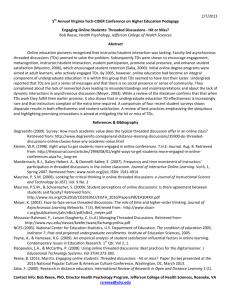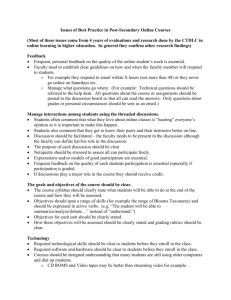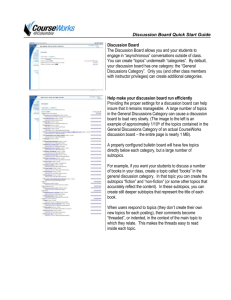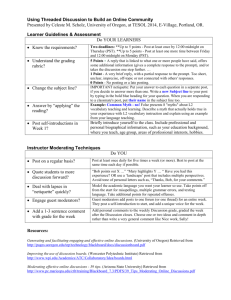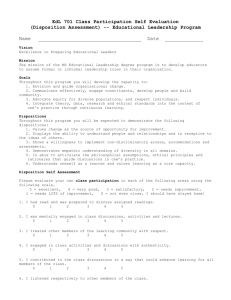2-page proposal file
advertisement
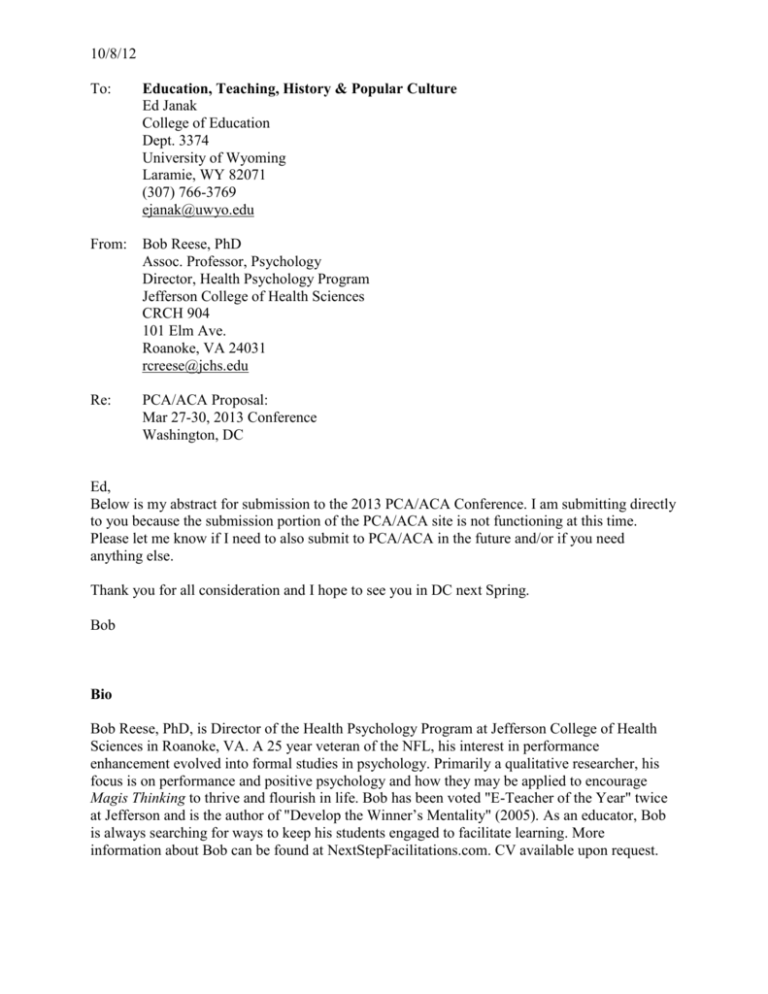
10/8/12 To: Education, Teaching, History & Popular Culture Ed Janak College of Education Dept. 3374 University of Wyoming Laramie, WY 82071 (307) 766-3769 ejanak@uwyo.edu From: Bob Reese, PhD Assoc. Professor, Psychology Director, Health Psychology Program Jefferson College of Health Sciences CRCH 904 101 Elm Ave. Roanoke, VA 24031 rcreese@jchs.edu Re: PCA/ACA Proposal: Mar 27-30, 2013 Conference Washington, DC Ed, Below is my abstract for submission to the 2013 PCA/ACA Conference. I am submitting directly to you because the submission portion of the PCA/ACA site is not functioning at this time. Please let me know if I need to also submit to PCA/ACA in the future and/or if you need anything else. Thank you for all consideration and I hope to see you in DC next Spring. Bob Bio Bob Reese, PhD, is Director of the Health Psychology Program at Jefferson College of Health Sciences in Roanoke, VA. A 25 year veteran of the NFL, his interest in performance enhancement evolved into formal studies in psychology. Primarily a qualitative researcher, his focus is on performance and positive psychology and how they may be applied to encourage Magis Thinking to thrive and flourish in life. Bob has been voted "E-Teacher of the Year" twice at Jefferson and is the author of "Develop the Winner’s Mentality" (2005). As an educator, Bob is always searching for ways to keep his students engaged to facilitate learning. More information about Bob can be found at NextStepFacilitations.com. CV available upon request. Engaging Online Students: Threaded Discussions - Hit or Miss? Abstract Online education pioneers recognized that instructor/student interaction was lacking. Faculty-led asynchronous threaded discussions (TDs) seemed to solve the problem. Subsequently TDs were shown to encourage engagement, metacognition, instructor/student interaction, student participation, promote social presence, and enhance student satisfaction (Maurino, 2006), which encouraged student retention (Saba, 2000). Initial online degree programs were aimed at adult learners, who actively engaged TDs. By 2005, however, online education had become an integral component of undergraduate education (NCES). It is within this group that TDs seemed to have lost their luster. Undergrads reported that TDs are just a series of messages and that there is no social presence or sense of community. They complained about the lack of nonverbal clues leading to misunderstandings and misinterpretations and about the lack of dynamic interactions in asynchronous discussion (Meyer, 2003). While a review of the literature confirms that that when TDs work they fulfill their earlier promise, it also shows that in undergraduate education TD effectiveness is increasingly rare and that faculty complain of the extra time required (Mandernach, Dailey-Hebert, & Donnelli-Sallee, 2007). A comparison of four recent student surveys shows disparate results in both effectiveness and student satisfaction.. A review of best practices is aimed at mitigating the hit or miss of TDs. References (DegreeInfo, n.d.; Maurino & Schoenacher, 2009; Mossavar-Rahmani & Larson-Daugherty, n.d.; Reese, in press) (Maurino & Schoenacher, 2009) (e.g., Klemm, 1998; Rizopoulos & McCarthy, 2008) DegreeInfo (2009). Survey: How much academic value does the typical threaded discussion offer in an online class? Retrieved from: http://www.degreeinfo.com/general-distancelearning-discussions/35900-do-threaded-discussions-online-classes-have-any-academicvalue.html Klemm, W.R. (1998). Eight ways to get students more engaged in online conferences. T.H.E. Journal. Aug. 8.Retrieved from: http://thejournal.com/articles/1998/08/01/eight-ways-toget-students-more-engaged-in-online-conferences.aspx?sc_lang=en Mandernach, B.J., Dailey-Hebert, A., & Donnelli-Sallee, E. (2007). Frequency and time investment of instructors’ participation in threaded discussions in the online classroom. Journal of Interactive Online Learning. Vol 6, 1, Spring 2007. Retrieved from: www.ncolr.org/jiol, ISSN: 1541-4914 Maurino, P. (2006). Looking for critical thinking in online threaded discussions. e-Journal of Instructional Science and Technology (e-JIST). Vol. 9 No. 2 Maurino, P.S.M., & Schoenacher, S. (2009). Student perceptions of online discussions: Is there agreement between students and faculty? Retrieved from: http://www.iiis.org/CDs2010/CD2010SCI/EISTA_2010/PapersPdf/EA304XV.pdf Meyer, K. (2003). Face-to-face versus threaded discussions: The role of time and higher-order thinking. Journal of Asynchronous Learning Networks. 7 (3). Retrieved from: http://www.sloan-c.org/publications/jaln/v8n2/pdf/v8n2_meyer.pdf Mossavar-Rahmani, F., Larson-Daugherty, C. (n.d.) Managing Threaded Discussions. Retrieved from: http://www.nyu.edu/classes/keefer/waoe/farhangcynthia.pdf NCES (2005). National Center for Education Statistics, U.S. Department of Education. The condition of education 2005, Indicator 7: Past and projected undergraduate enrollments. Institute of Education Sciences, 2005. Rizopoulos, L.A., & McCarthy, P. (2008). Using online threaded discussions: Best practices for the digital learner. J Educational Technology Systems. Vol 37(4) 373-383. Reese, B. (In Press). Student Surveys from Online Courses 2010-12. Saba, F. (2000). Research in distance education. International Review of Research in Open and Distance Learning 1 (1).
